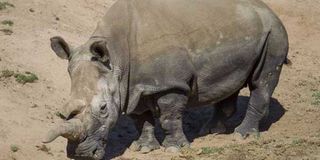Death of Nola, at 41, could be pointer to a bleak future

This photo obtained November 23, 2015 courtesy of the San Diego Zoo shows Nola, a 41-year-old northern white rhino who died November 22, 2015 at the San Diego Zoo Safari Park in California. AFP PHOTO |SAN DIEGO ZOO | AFP
What you need to know:
The zoo’s obituary described Nola as an “iconic animal,’ adding, “Nola leaves a legacy that her keepers and animal care staff will continue to help rhino conservation for years to come.”
Five mass extinctions have occurred on Earth.
A death a week on Sunday drew little attention while the deceased got a brief obituary.
Nola, aged about 41, died in a United States zoo. Her male companion died last December. Nola might have smooched died in July in a Czech Republic zoo.
The remaining three aging members of the species—the northern white rhino—remain in a Kenyan conservancy.
The zoo’s obituary described Nola as an “iconic animal,’ adding, “Nola leaves a legacy that her keepers and animal care staff will continue to help rhino conservation for years to come.”
More befitting would have been “species conservation.”
MASS EXTINCTION
These rhinos were moved from the Czech zoo in hope new surroundings might encourage reproduction to avoid extinction.
Now, the remaining two females are past reproduction-by-age; the male’s sperm is kaput.
While species mass extinctions have occurred, extinction also does normally.
But because nobody knows how many species exist or have existed on Earth, predictions of what might happen are dicey.
Nonetheless, using current knowledge and what’s known as “background extinction rate”—a measure of “how often” extinctions occur—scientists often compare the present extinction and normal extinction rates.
That would show which way the situation might be heading.
Five mass extinctions have occurred on Earth.
They resulted from cataclysmic—violent upheavals.
For example: meteor strikes, extreme climate changes, volcanic eruptions, et al. The first mass extinction occurred about 439 million years ago; the last, and considered worst, about 65. Those were pre-humans times.
DINOSAURS' EXTINCTION
Noting dinosaurs’ extinction 65 million years ago, a CNN correspondent wrote in June: “Today, a sixth mass extinction could be well underway and humans are the likely culprits.” No wonder humans are gathered in Paris this week for another round of blame games on which countries are most to blame.
The CNN story was referring to findings by Gerardo Ceballos, of National Autonomous University of Mexico, and Anthony Barnosky, a biology professor at Berkeley, in the US.
They argued 477 vertebrate species have gone extinct since 1900. Had it not been for human activities, only two would have.
They fear 75 per cent of species known today are likely to go extinct in two generations. That’s fast
Most species extinctions occur in obscure places.
The significance of Nola & Co. is it’s occurring in full view. Denial isn’t possible.
Humans know these animals didn’t and aren’t fighting to death; lions are innocent; Homo sapiens got reckless.
Species symbiosis sustains Earth. Once one is destroyed—not left to natural extinction—Earth’s decay advances a notch.
That decay might take millions of years to cause human extinction isn’t guaranteed.




